-
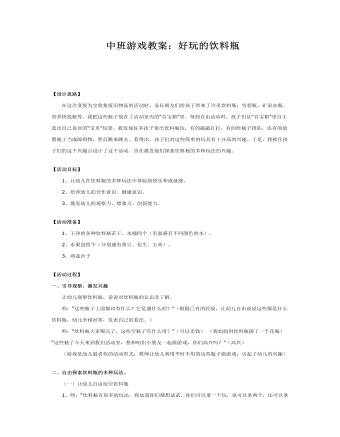
中班游戏教案:好玩的饮料瓶
【活动目标】1、让幼儿在饮料瓶的多种玩法中体验到快乐和成就感。2、培养幼儿的合作意识、健康意识。3、激发幼儿的观察力、想象力、创新能力。【活动准备】1、干净的各种饮料瓶若干、水桶四个(里面盛有不同颜色的水)。2、水果盘四个(分别盛有黄豆、花生、玉米)。3、两盆沙子【活动过程】一、引导观察,激发兴趣 让幼儿观察饮料瓶,说说对饮料瓶的认识及了解。 师:“这些瓶子上面都印有什么?它是盛什么的?”(根据已有的经验,让幼儿自由说说这些都是什么饮料瓶,幼儿争相回答,发表自己的看法。) 师:“饮料被大家喝完了,这些空瓶子有什么用?”(可以卖钱)(我妈妈用饮料瓶做了一个花瓶)“这些瓶子今天来到我们活动室,想和咱们小朋友一起做游戏,你们高兴吗?”(高兴) (游戏是幼儿最喜欢的活动形式,教师让幼儿利用平时不用的这些瓶子做游戏,引起了幼儿的兴趣)
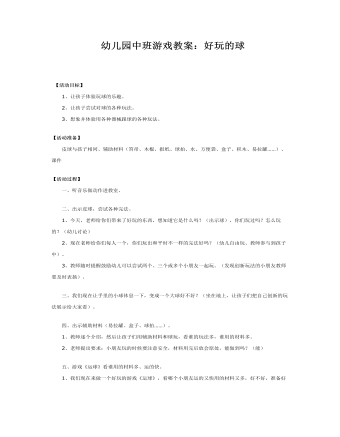
幼儿园中班游戏教案:好玩的球
2、让孩子尝试对球的各种玩法。3、想象并体验用各种器械跟球的各种玩法。【活动准备】 皮球与孩子相同、辅助材料(笤帚、木棍、报纸、球拍、水、方便袋、盒子、积木、易拉罐……)、课件【活动过程】 一、听音乐做动作进教室。 二、出示皮球,尝试各种完法。1、今天,老师给你们带来了好玩的东西,想知道它是什么吗?(出示球),你们玩过吗?怎么玩的?(幼儿讨论)2、现在老师给你们每人一个,你们玩出和平时不一样的完法好吗?(幼儿自由玩、教师参与到孩子中)。3、教师随时提醒鼓励幼儿可以尝试两个、三个或多个小朋友一起玩。(发现创新玩法的小朋友教师要及时表扬)。
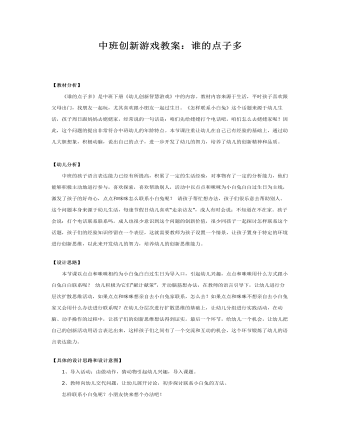
中班创新游戏教案:谁的点子多
【幼儿分析】 中班的孩子语言表达能力已经有所提高,积累了一定的生活经验,对事物有了一定的分析能力,他们能够积极主动地进行参与,喜欢探索,喜欢帮助别人,活动中以点点和咪咪为小白兔白白过生日为主线,激发了孩子的好奇心,点点和咪咪怎么联系小白兔呢?请孩子帮忙想办法,孩子们很乐意去帮助别人。这个问题本身来源于幼儿生活,每逢节假日幼儿喜欢“走亲访友”,成人有时会说:不知道在不在家。孩子会说:打个电话联系联系吗。成人也很少意识到这个问题的创新价值,很少同孩子一起探讨怎样联系这个话题,孩子们的经验知识停留在一个表层,这就需要教师为孩子设置一个情景,让孩子置身于特定的环境进行创新思维,以此来开发幼儿的智力,培养幼儿的创新思维能力。【设计思路】 本节课以点点和咪咪相约为小白兔白白过生日为导入口,引起幼儿兴趣,点点和咪咪用什么方式跟小白兔白白联系呢?幼儿积极为它们“献计献策”,开动脑筋想办法,在教师的语言引导下,让幼儿进行分层次扩散思维活动,如果点点和咪咪想亲自去小白兔家联系,怎么去?如果点点和咪咪不想亲自去小白兔家又会用什么办法进行联系呢?在幼儿分层次进行扩散思维的基础上,让幼儿分组进行实践活动,在动脑、动手操作的过程中,让孩子们的创新思维想法得到证实。最后一个环节,给幼儿一个机会,让幼儿把自己的创新活动用语言表达出来,这样孩子们之间有了一个交流和互动的机会,这个环节锻炼了幼儿的语言表达能力。
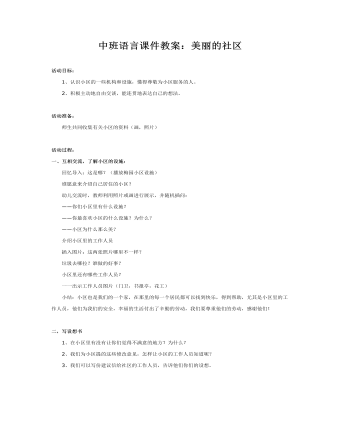
中班语言课件教案:美丽的社区
活动准备: 师生共同收集有关小区的资料(画,照片) 活动过程:一、互相交流,了解小区的设施: 回忆导入:这是哪?(播放梅园小区设施) 谁愿意来介绍自己居住的小区? 幼儿交流时,教师利用照片或画进行展示,并随机插问:——你们小区里有什么设施?
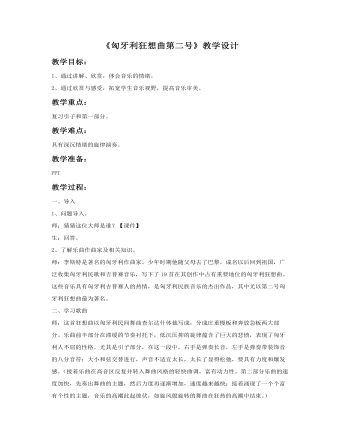
《匈牙利狂想曲第二号》教案
教学过程:一、导入1、问题导入。师:猜猜这位大师是谁?【课件】生:回答。2、了解乐曲作曲家及相关知识。师:李斯特是著名的匈牙利作曲家。少年时期他随父母去了巴黎,成名以后回到祖国,广泛收集匈牙利民歌和吉普赛音乐,写下了19首在其创作中占有重要地位的匈牙利狂想曲。这些音乐具有匈牙利吉普赛人的热情,是匈牙利民族音乐的杰出作品,其中尤以第二号匈牙利狂想曲最为著名。二、学习歌曲师:这首狂想曲以匈牙利民间舞曲查尔达什体裁写成,分成庄重慢板和奔放急板两大部分。乐曲前半部分在滞缓的节奏衬托下,低沉压抑的旋律蕴含了巨大的悲愤,表现了匈牙利人不屈的性格。尤其是引子部分,在这一段中,右手是弹奏长音,左手是弹奏带装饰音的八分音符;大小和弦交替进行,声音不适宜太长,太长了显得松弛,要具有力度和爆发感。(接着乐曲在高音区反复并转入舞曲风格的轻快曲调,富有动力性。第二部分乐曲的速度加快,先奏出舞曲的主题,然后力度再逐渐增加,速度越来越快;接着涌现了一个个富有个性的主题,音乐的高潮此起彼伏,如旋风般旋转的舞曲在狂热的高潮中结束。)
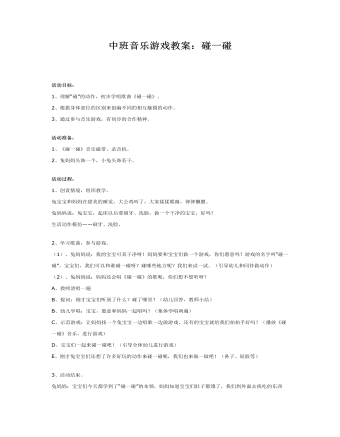
中班音乐游戏教案:碰一碰
活动准备: 1、《碰一碰》音乐磁带,录音机。 2、兔妈妈头饰一个,小兔头饰若干。活动过程: 1、创设情境,组织教学。 兔宝宝和妈妈在甜美的睡觉,大公鸡叫了,大家揉揉眼睛,伸伸懒腰。 兔妈妈说:兔宝宝,起床以后要刷牙、洗脸,做一个干净的宝宝,好吗? 生活动作模仿――刷牙、洗脸。2、学习歌曲,参与游戏。 (1)、兔妈妈说:我的宝宝可真干净呀!妈妈要和宝宝们做一个游戏,你们愿意吗?游戏的名字叫“碰一碰”。宝宝们,我们可以和谁碰一碰呀?碰哪些地方呢?我们来试一试。(引导幼儿和同伴做动作)
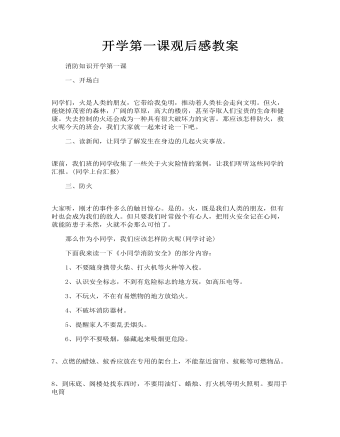
开学第一课观后感教案
三、防火 大家听,刚才的事件多么的触目惊心。是的。火,既是我们人类的朋友,但有时也会成为我们的敌人。但只要我们时常做个有心人,把用火安全记在心间,就能防患于未然,火就不会那么可怕了。 那么作为小同学,我们应该怎样防火呢(同学讨论) 下面我来读一下《小同学消防安全》的部分内容: 1、不要随身携带火柴、打火机等火种等入校。 2、认识安全标志,不到有危险标志的地方玩,如高压电等。 3、不玩火,不在有易燃物的地方放焰火。 4、不破坏消防器材。 5、提醒家人不要乱丢烟头。 6、同学不要吸烟,躲藏起来吸烟更危险。
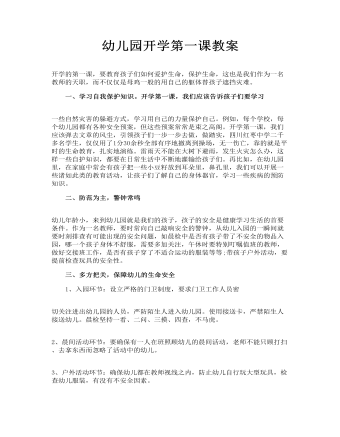
幼儿园开学第一课教案
二、防范为主,警钟常鸣 幼儿年龄小,来到幼儿园就是我们的孩子,孩子的安全是健康学习生活的首要条件。作为一名教师,要时常向自己敲响安全的警钟,从幼儿入园的一瞬间就要时刻排查有可能出现的安全问题,如晨检中是否有孩子带了不安全的物品入园,哪一个孩子身体不舒服,需要多加关注,午休时要特别叮嘱值班的教师,做好交接班工作,是否有孩子穿了不适合运动的服装等等;带孩子户外活动,要提前检查玩具的安全性。
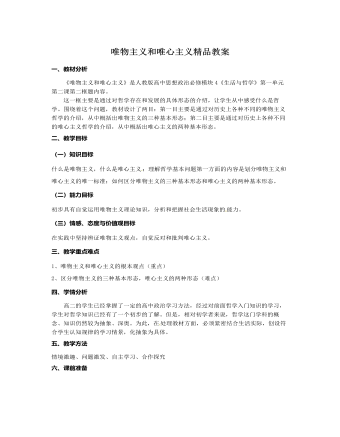
人教版高中政治必修4唯物主义和唯心主义精品教案
一、教材分析《唯物主义和唯心主义》是人教版高中思想政治必修模块4《生活与哲学》第一单元第二课第二框题内容。这一框主要是通过对哲学存在和发展的具体形态的介绍,让学生从中感受什么是哲学。围绕着这个问题,教材设计了两目:第一目主要是通过对历史上各种不同的唯物主义哲学的介绍,从中概括出唯物主义的三种基本形态;第二目主要是通过对历史上各种不同的唯心主义哲学的介绍,从中概括出唯心主义的两种基本形态。二、教学目标(一)知识目标什么是唯物主义,什么是唯心主义 ;理解哲学基本问题第一方面的内容是划分唯物主义和唯心主义的唯一标准;如何区分唯物主义的三种基本形态和唯心主义的两种基本形态。(二)能力目标初步具有自觉运用唯物主义理论知识,分析和把握社会生活现象的 能力。(三)情感、态度与价值观目标在实践中坚持辨证唯物主义观点,自觉反对和批判唯心主义。三、教学重点难点1、唯物主义和唯心主义的根本观点(重点)
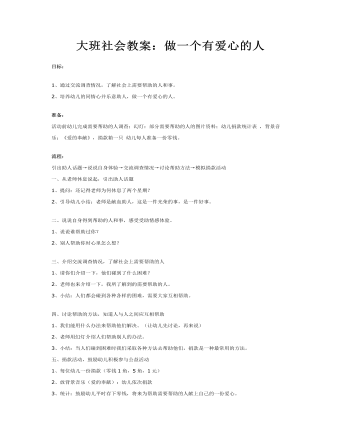
大班社会教案:做一个有爱心的人
准备:活动前幼儿完成需要帮助的人调查;幻灯:部分需要帮助的人的图片资料;幼儿捐款统计表,背景音乐:《爱的奉献》,捐款箱一只幼儿每人准备一份零钱。流程:引出助人话题→说说自身体验→交流调查情况→讨论帮助方法→模拟捐款活动一、从老师休息说起,引出助人话题 1、提问:还记得老师为何休息了两个星期?2、引导幼儿小结:老师是献血助人,这是一件光荣的事,是一件好事。二、说说自身得到帮助的人和事,感受受助情感体验。1、说说谁帮助过你?2、别人帮助你时心里怎么想?
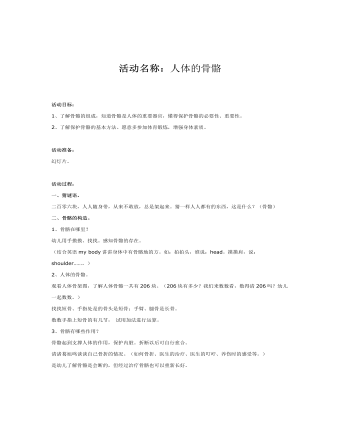
中班主题课件教案:人体的骨骼
2、了解保护骨骼的基本方法。愿意多参加体育锻炼,增强身体素质。 活动准备:幻灯片。 活动过程:一、猜谜语。二百零六块,人人随身带,从来不敢放,总是架起来。猜一样人人都有的东西,这是什么?(骨骼)二、骨骼的构造。1、骨骼在哪里?幼儿用手摸摸、找找。感知骨骼的存在。(结合英语my body讲讲身体中有骨骼地的方。如:拍拍头,谁说:head。摸摸肩,说:shoulder……。)
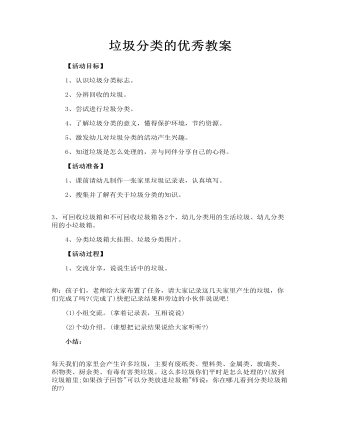
垃圾分类的优秀教案 垃圾分类优秀教案3篇
1、交流分享,说说生活中的垃圾。 师:孩子们,老师给大家布置了任务,请大家记录这几天家里产生的垃圾,你们完成了吗?(完成了)快把记录结果和旁边的小伙伴说说吧! (1)小组交流。(拿着记录表,互相说说) (2)个幼介绍。(谁想把记录结果说给大家听听?)

人教版高中历史必修2从“战时共产主义”到“斯大林模式”教案
5、弊端:(1)经济发展不均衡,片面发展重工业,使轻工业和农业长期处于落后状态;(2)对农民的剥夺太重,挫伤了农民的生产积极性;(3)长期执行指令性计划严重削弱了企业的生产自主权,不利于发挥企业的生产积极性,制约了苏联经济的可持续发展。(4)计划经济体制确立后,没有随着社会的变化进行调整,二战后逐渐僵化,丧失了自我完善的功能,成为苏联解体的重要因素。【合作探究】斯大林模式的评价及经验教训:积极:①使苏联迅速实现了 工业化②苏联经济实力的迅速增长,为反法西斯战争的胜利奠定了 物质基础 。消极:①政治:高度集权,破坏了 民主与法制 ; ②经济:优先发展重工业使 农业和轻工业长期处于落后状态,农民生产积极性不高;计划指令,压制了地方和企业的积极性,阻碍苏联经济的发展高度集中的计划经济体制,成为东欧剧变和苏联解体的重要原因。
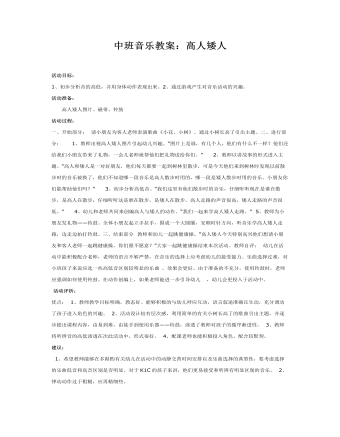
中班音乐教案:高人矮人
活动过程:一、开始部分: 请小朋友为客人老师表演歌曲《小花、小树》。通过小树长高了引出主题。二、进行部分: 1、教师出视高人矮人图片引起幼儿兴趣。“图片上是谁,有几个人,他们有什么不一样?他们还给我们小朋友带来了礼物,一会儿老师就帮他们把礼物送给你们。”2、教师以讲故事的形式进入主题。“高人和矮人是一对好朋友,他们每天都要一起到树林里散步,可是今天他们来到树林时发现以前散步时的音乐被换了,他们不知道哪一段音乐是高人散步时用的,哪一段是矮人散步时用的音乐。小朋友你们能帮助他们吗?”3、初步分析高低音。“我们这里有他们散步时的音乐,仔细听听现在是谁在散步,是高人在散步,仔细听听这是谁在散步,是矮人在散步。高人走路的声音很高,矮人走路的声音很低。

中班主题课件教案:美丽的孔雀(说课和教案)
【说教材】 孔雀是孩子们喜欢的鸟类,他们在电视上、图书中见到过孔雀,而该活动进一步加深幼儿对孔雀的了解。《纲要》中指出:让幼儿感受生活的美,能用自己喜欢的方式表现自己的感受。因此我选择了这一活动,让幼儿大胆地展示自己。我班的幼儿大多数没上过幼儿园,在语言表达能力方面有些欠缺,但他们敢于用动作表现自己。【说目标】通过《纲要》的要求及对教材的分析,我制定了以下活动目标:(1)学习冠形、掌形和孔雀展翅的动作,能随音乐轻柔、优美地进行表演。(2)了解孔雀的外形特征和生活习性。(3)产生喜爱孔雀、爱护孔雀的情感。【说活动重、难点】从活动目标看出本节活动的重难点是:了解孔雀的外形特征及学习冠形、掌形和孔雀展翅的动作,并随音乐表演。

中班棉签画教案:漂亮的大鱼课件教案
2、观看幼儿示范,倾听教师讲解,学习在指定范围内画彩色的点,表现美丽的大鱼。 3、学会认真、耐心地进行美术活动。 活动准备: 1、幼儿用书人手一册,棉签若干,颜料盘每组2-3盘。 2、水墨画、油画棒、水彩等形式表现的各种形态的鱼。 3、在白纸上画一条鱼的线条。 活动过程:一、听谜面、猜谜语、引出主题。 教师:有头没有颈,身上亮晶晶,有翅不能飞,没脚倒能行。这是一种生活在水里的动物,请你猜一猜这是什么动物?

中班艺术教案:会变魔术的手课件教案
2、尝试在手套上画,贴的技能。 3、培养幼儿在手的造型上进行大胆夸张的装饰、涂画,能打扮出美观的图案。 活动准备 1、课前教幼儿玩手形游戏。 2、手套每人1副、水彩笔、胶棒、彩色纸、皮筋、幕、磁带、魔术用具活动过程一、以游戏的形式导入主题 1、请幼儿带着手套听音乐进入教室。 2、教师在幕后分别出示1只手1双手吸引幼儿的注意,“啊!”这是一双会变魔术的手。 请魔术师随着音乐变魔术。 3、请幼儿上来尝试变魔术,用手套做各种不同的造型。让幼儿说说自己做的是什么,是怎么变的。请全体幼儿来学一学。
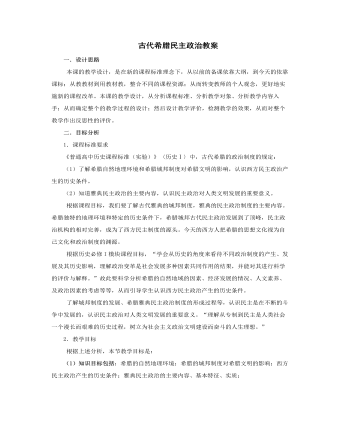
人教版高中历史必修1古代希腊民主政治教案
二.运用思考题目,激发学生对本课问题的探究,检查学生在学习过程中,结合所学的知识,对问题的思考、质疑;从而学会查阅、搜集资料,分析、整理;通过讨论、交流,得出新的认识。学生可根据自己的实际情况和个人爱好,可选择不同的作业呈现方式,包括作业的问题的选择、缴交的方式(制作、小论文、课件)等等,从而体现学生对古代希腊雅典民主政治产生的条件、雅典民主政治的内容及其意义的认识的程度。1.“东西方不同政治制度选择的因素分析”(课前)2.古代雅典民主政治制度对人类文明的影响。(课后)七.反思与总结本课的设计在实施过程中,总体效果比较好,对课标的要求基本达至。尤其是通过东西方不同政治制度选择的对比,不但复习了旧的知识,而且加深了对新知识的掌握,从而有更深入的认识。学生在这个问题的学习过程中,通过课前自身的活动(搜集、查阅资料),逐步培养历史的学习的方法;在课堂上,同学们通过讨论的过程,互相交流、分享心得体会;逐步提高自己的思维能力。
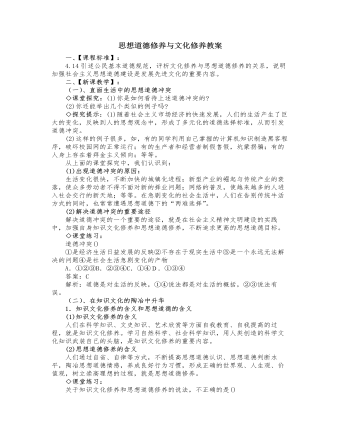
人教版高中政治必修3思想道德修养与文化修养教案
(2)这样的例子很多,如,有的同学利用自己掌握的计算机知识制造黑客程序,破坏校园网的正常运行;有的生产者和经营者制假售假,坑蒙拐骗;有的人身上存在着拜金主义倾向;等等。从上面的课堂探究中,我们认识到:(1)出现道德冲突的原因:生活变化很快,不断加快的城镇化进程;新型产业的崛起与传统产业的衰落,使众多劳动者不得不面对新的择业问题;网络的普及,使越来越多的人进入社会交行的新天地;等等。在急剧变化的社会生活中,人们在告别传统牛活方式的同时,也常常遭遇思想道德下的“两难选择”。(2)解决道德冲突的重要途径解决道德冲突的一个重要的途径,就是在社会主义精神文明建设的实践中,加强自身知识文化修养和思想道德修养,不断追求更高的思想道德目标。◇课堂练习:道德冲突()①是经济生活日益发展的反映②不存在于现实生活中③是一个永远无法解决的问题④是社会生活急剧变化的产物
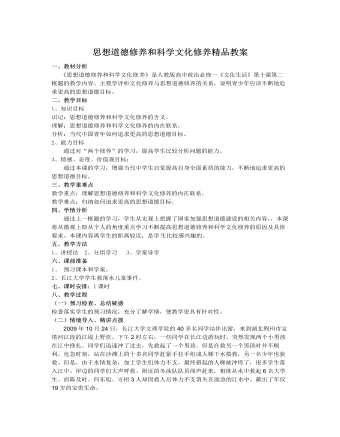
人教版高中政治必修3思想道德修养和科学文化修养精品教案
一、教材分析《思想道德修养和科学文化修 养》是人教版高中政治必修一《文化生活》第十课第二框题的教学内容。主要学评析文化修养与思想道德修养的关系,说明青少年应该不断地追求更高的思想道德目标。二、教学目标1、知识目标识记:思想道德修养和科学文化修养的含义。理解:思想道德修养和科学文化修养的内在联系。分析:当代中国青年如何追求更高的思想道德目标。2、能力目标通过对“两个修养”的学习,提高学生比较分析问题的能力。3、情感、态度、价值观目标:通过本课的学习,增强当代中学生自觉提高自身全面素质的能力,不断地追求更高的思想道德目标。三、教学重难点教学重点:理解思想道德修养和科学文化修养的内在联系。教学难点:归纳如何追求更高的思想道德目标。四、学情分析通过上一框题的学习,学生从宏观上把握了国家加强思想道德建设的相关内容,,本课将从微观上即从个人的角度重点学习不断提高思想道德修养和科学文化修养的原因及具体要求。本课内容离学生的距离较近,是学 生比较感兴趣的。





















